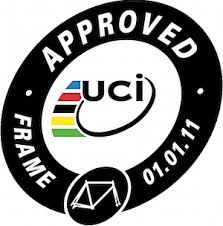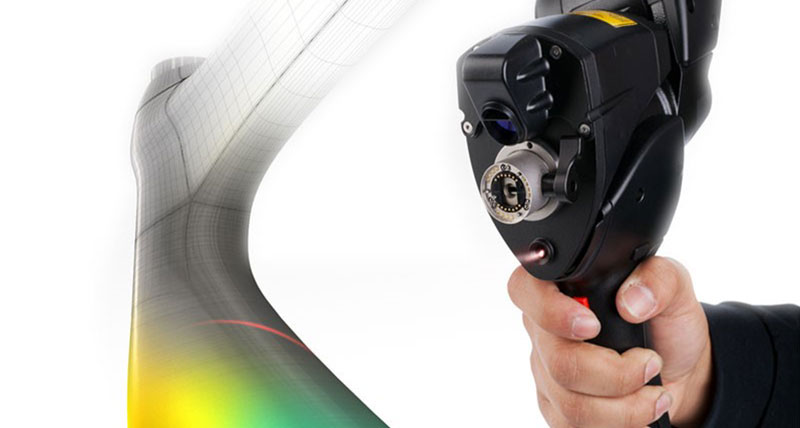Portable metrology helps ensure safety and fairness at the Tour de France
Union Cyclist Internationale - France
Contact us

Every bicycle frameset used at the Tour de France (and any machine raced at any UCI sanctioned bicycle event for that matter) is validated by the Union Cyclist Internationale (UCI). Enabling this intensive process is a bike measurement system based on a ROMER Absolute Arm from Hexagon Manufacturing Intelligence. This Portable Coordinate Measurement Machine (PCMM) is used to ensure that every bicycle frame and fork meet rigid UCI standards. Once inspected, the frameset is issued a UCI approval sticker and thus made race-legal at any UCI approved event anywhere around the world.
UCI approval sticker origins
On January 1, 2011, the UCI implemented a formal frame approval process for racing bicycles. The rationale for this was multifold. First, the sport’s governing body wanted to streamline the existing bike validation process, which was traditionally carried out by race commissaries at each race — a costly and controversy-prone process. In addition, the UCI wanted to improve frame safety (ensure that materials were robust and race-worthy), while also enhancing fairness by enacting a formal process to ensure UCI-approved frame geometry guidelines were enforced.
In turn, this validation standard would benefit manufacturers by improving their mass production and eliminating situations where frame builders learn "after the fact" their products have failed inspection. The process would also level the playing field and prevent a bicycle “arms race”, due to equipment shortfalls.
Validation process
In order to obtain a UCI frame validation sticker, manufacturers must comply with a standard approval process. To start, the frame manufacturer must submit technical drawings of their designs1 and a full scale prototype to the UCI for inspection. Once approved, the frameset must carry a UCI-approval sticker that is “indelible and inseparable from the frame” — under the clear coat of the frame — to be legal for competition. The entire process takes about two months. To accurately interpret the design drawings, UCI recruited the assistance of local Engineering University Ecole Polytechnique Federale de Lausanne (Aigle, Switzerland). The UCI selected a very well qualified university for this work. The Ecole Polytechnique Federale de Lausanne is currently ranked 14th on the 2015 QS World University Ranking list; the Laboratory of Polymer and Composite Technology (LTC) is a leader in the development and analysis of composite materials like carbon fiber, Kevlar, and next generation composite materials. The University uses 3D scan data submitted by the frame manufacturer, and verifies the 3D scan data captured from the prototype meets dimensions outlined in the previously approved technical drawings.
1 Approval Protocol for Frames and Forks, pg. 16: “All the files sent must be in PDF and STEP formats (or SolidWorks formats), in order to have a printable version and another version usable with computer-aided design (CAD) software. The 3D version is also used to check compliance of the physical dimensions of an actual prototype.

Figure 1: The UCI approved frame sticker must be "indelible and inseparable" from the bicycle frame.
Speed and accuracy for frame validation
When the UCI enacted this frame validation standard, they encountered a logistical challenge. How could they rapidly and accurately confirm the frames were meeting their requirements? Additionally, what could they do to accelerate the process? A backlog of frames were mounting as the sport’s governing body could not approve them for racing. UCI inspectors needed a solution to improve the speed of scanning and provide the accuracy necessary to meet frame geometry requirements.
The crux of UCI's challenge was centered on measurement. The expedient action was to reach out to an expert in dimensional measurement. Hexagon Manufacturing Intelligence, a leader in the metrology industry, has its Swiss headquarters in Crissier, Switzerland. The precision center at this location was an ideal location for tackling inspection issues. A close collaboration between UCI and Hexagon resulted in a purpose-built ROMER Absolute Arm Bike Measurement System for use in the validation process. The completely portable 3D scanning system was developed in Switzerland with the UCI and the Laboratory of Polymer and Composite Technology (LTC) at the Swiss Federal Institute of Technology (EPFL).
How it works
The dedicated measurement software is built on InnovMetric's PolyWorks® software. Using just 9 simple commands, users can check the validity of the physical bike frame against its associated CAD model in minutes and generate easy to understand checking reports. An inspector simply moves the scanner over different sections of the frame as it collects 3D points from the frame surface. The ease of movement of the ROMER Absolute Arm allows UCI officials to check even difficult to reach areas on the bicycle. The PCMM also delivers a high level of non-contact scanning performance, even on highly reflective carbon fiber surfaces.

Figure 2: The ROMER Absolute Arm Bike Measurement System provides the speed, accuracy and portability that UCI frame inspectors need to validate bicycle framesets for competition.
After extensive testing, the ROMER Absolute Arm Bike Measurement System is now the UCI's approved solution for checking bike frame legality, whatever the frame, material type, or even location. UCI leverages a variety of features to enable speed, accuracy, and portability. The laser scanner collects 480,000 data points per second from the bike frame's surface: an entire frame can be measured and checked in just minutes. Those 3D points are compared to the CAD model and assigned colors according to their deviation from the CAD model. The final result is an easy to understand inspection report. The ROMER Absolute Arm's compact design and lightweight allows users to transport and use it anywhere.
ROMER Absolute Arm with integrated scanner
The portable laser scanner solution is also cost-efficient. No additional cable or controller between the laser scanner and the portable measuring arm is required, facilitating the ROMER Absolute Arm's infinite rotation of the main movement axes. With sophisticated balance characteristics, the PCMM with integrated scanner can be operated with one hand. Coupled with the PolyWorks application software, the UCI has an end-to-end scanning and software package with all the tools needed to rapidly and accurately validate frames to meet their requirements.
Standardizing on the ROMER Absolute Arm
Today, the UCI has fully standardized frame measurement operations based on the ROMER Absolute Arm Bike Measurement System. The organization is so confident in the results and the portability of the system that officials worldwide use the technology to confirm bicycle frames are in compliance with their regulations. In addition to helping the UCI meet their speed and accuracy targets, these PCMMs also assist frame manufacturers by catching potential violations before they make tooling and manufacturing investments. By focusing on the design and prototype phase, the UCI is able to ensure safety and design parameters are met without wasteful scrapping of built framesets.
As the Tour de France concludes its 2,197 mile circuit of France on July 24, 2016, the pageantry of the event will climax on the Avenue des Champs-Élysées in Paris. Unknown to most riders and spectators, the bicycles used by each athlete have their origins in a lab in Switzerland, being validated by a ROMER Absolute Arm system. This partnership has enabled UCI to establish critical standards for the world’s best cyclists to race 6.8 kg (15 lbs) bicycles for thousands of miles a season, with complete confidence in their machines at speeds approaching 70 mph. Cyclists of all stripes, whether they are sprinting for victories on the world stage or just riding around their neighborhood, benefit from these regulations validated with a ROMER Absolute Arm Bike Measurement System.